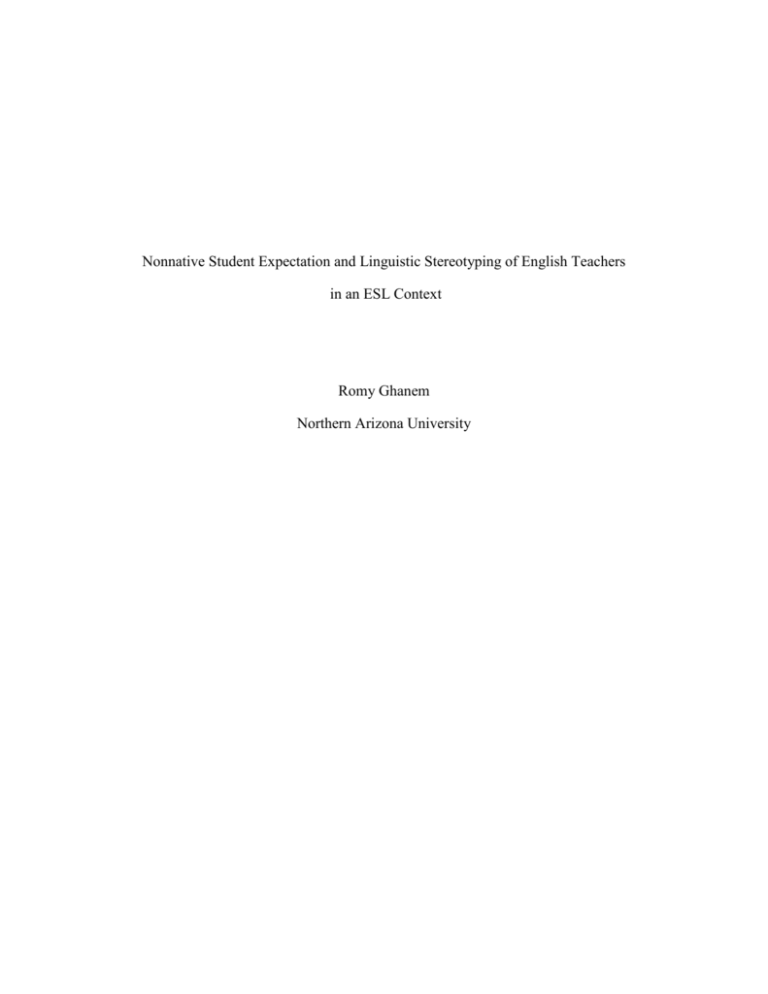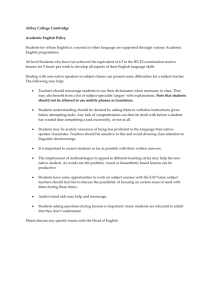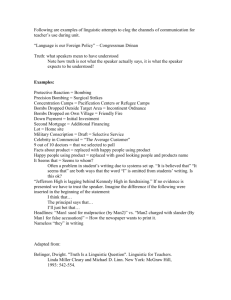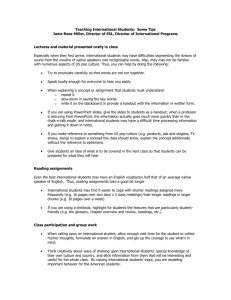Nonnative Student Expectation and Linguistic Stereotyping of
advertisement

Nonnative Student Expectation and Linguistic Stereotyping of English Teachers in an ESL Context Romy Ghanem Northern Arizona University NONATIVE STUDENT EXPECTATION AND LINGUISTIC STEREOTYPING 2 Abstract This paper is based on the Reverse Linguistic Stereotype theory which stipulates that paralinguistic characteristics affect a listener’s perception of a particular production. The study investigates whether the RLS theory can be applied across the globe in an attempt to show that even ESL students are affected by nonlinguistic cues and have preconceived ideas about nonnative teachers. Thirty nine students enrolled at the Program of Intensive English were asked to listen to three speech samples produced by an advanced nonnative speaker. Using the match guise technique, students were led to believe there were two speakers: a Caucasian teacher and an Eastern Asian one. Results showed that students did not show proclivity to RLS as measured by the Speech Evaluation Instrument. However, their comprehension scores and teacher competence ratings were significantly higher when they thought their teacher was Caucasian. The findings of this study could inform on ESL classroom dynamics and the way students view their nonnative English teachers. NONATIVE STUDENT EXPECTATION AND LINGUISTIC STEREOTYPING 3 Background Listeners’ perception has been shown to be influenced by a variety of factors. Over the past few decades, researchers have focused on the linguistic and paralinguistic aspects of an utterance and how these affect judgment. The most prominent experiment was Rubin’s guisematching technique (Rubin & Smith, 1990; Rubin, 1992; Kang & Rubin, 2009). Much research that followed this study investigated the effect of different types of non-linguistic cues on listeners’ perception. In one such study, Rubin (1992) investigated students’ perceptions towards nonnative teachers. The major finding in this paper is that undergraduate students rated native speaker speech with an Eastern Asian guise as if they were listening to nonnative speech. Rubin argued that the social background information of the speaker in fact induced the perception of the accent and not the speech itself. An extensive study was also conducted by Kang (2008) who not only evaluated undergraduate perceptions of ITA’s but also determined whether a socio-cultural intervention program would raise awareness in the participants and change their preconceived ideas. Seventy six undergraduate students were recruited for this experiment which was divided into two phases. The findings of her study showed that attitudes towards nonnative speakers do affect the participants’ ratings of those speakers. The most interesting finding is that the intervention program did in fact yield results and created some change in the participants’ perceptions. Kang and Rubin (2009) also investigated this issue a year later in relation to Chinese ITAs and how American undergraduate students perceive them. For the experiment, a native speaker (who teaches a speech class at the university level) recorded two speech samples. The samples were shown with both Eastern European and Eastern Asian guises. Results showed that individuals who have preconceived stereotypical views about nonnative speakers rated the NONATIVE STUDENT EXPECTATION AND LINGUISTIC STEREOTYPING 4 Chinese guise sample as accented (despite the fact that they had just listened to a native speaker sample). Another interesting finding is that listeners who view NNSs as socially unattractive (i.e. distant, aloof, insincere) performed poorly on the comprehension test, i.e. they missed some of the information presented when they thought that the speaker was Chinese. Speakers who exhibited all aforementioned views towards a nonnative speaker gave low ratings to the Chinese guise in regards to their teaching proficiency. As it can be seen from the above review, most of the studies that have investigated RLS did so with native speaker listeners. However such an issue cannot be disregarded in an ESL context because in this setting, the English language is not simply the medium of delivery of information but the target objective. Thus, predisposition to RLS cannot only affect students’ perceptions and attitudes but also their comprehension and proficiency in the language. Research Questions 1. Do ESL students exhibit proclivity to RLS when it comes to comprehension of material delivered by a nonnative English teacher? 2. Do students show propensity to RLS when rating a nonnative teacher according to the Speech Evaluation Instrument? 3. Do students demonstrate RLS when rating the teaching competence of a nonnative English teacher? 4. Does L1 background affect an ESL student’s comprehension scores, speech evaluation, and teacher competence ratings? NONATIVE STUDENT EXPECTATION AND LINGUISTIC STEREOTYPING 5 Methods Students were asked to listen to three two-minute lectures on Conditionals in the English language. The second and third types of conditionals were produced by an advanced Korean speaker of English. The first type was produced by an intermediate Chinese speaker and used as a distractor (i.e. it was always played between the other two). Each experimental speech sample was played with one of two guises: Eastern Asian guise or Caucasian one. After each speech sample, the students were given two forms to fill out: the first was a comprehension test measuring to measure the amount of information they retained from the lectures and the second a survey which includes their speech evaluation and teacher competence ratings of the speaker they just heard. The order and combination of the speech samples and guises was varied across the three groups of participants. Results The results showed that there was a significant difference between the mean scores of the comprehension tests when the guise was Caucasian guise (M = 59.23) and when it was Eastern Asian (M = 50.26). This finding is consistent with previous studies (Kang & Rubin, 2009) which have shown that listeners may suffer comprehension loss when they have negative views towards the speaker’s teaching abilities. The findings also demonstrated that there was no significant difference between the speech evaluation ratings of the Eastern Asian guise and those of the Caucasian guise. This could be due to the fact that the ESL students saw a speaker who shares their culture and values and therefore did not rate them that differently according to the Speech Evaluation Instrument (which included: social attractiveness, superiority, and dynamism). However, the results did show significant differences in listener ratings with regards to teaching NONATIVE STUDENT EXPECTATION AND LINGUISTIC STEREOTYPING 6 competence. The ratings given to the Eastern Asian guise (M = 4.7) were statistically lower than those of the Caucasian guise (M = 5.1). This result confirms previous research that shows that a lot of students avoid nonnative speaker teachers or international teaching assistants and have negative preconceived ideas towards them (Rubin, 1992; Rubin, 2002; Kang & Rubin, 2009). Finally, there was no interaction between the students’ nationalities and the two guises, i.e. students from different cultural backgrounds rated the two guises in the same manner. This could either be because all ESL students share similar preconceptions and expectations when it comes to a nonnative English teacher or it could be because the number of participants was not evenly distributed between both cultural groups (Eastern Asia: 26; Gulf: 10). More research on this topic is needed to determine the answer to this question. Relevance to PIE and Second language Learning As this paper has shown, ESL students might accept nonnative teachers on a sociocultural level, yet it is clear that they do not do so in an academic setting. It is obvious that these students have preconceived ideas about nonnative teachers which may or may not be appeased in time. Some students claimed they would like their own teacher (a nonnative one) to teach them English because he is extremely qualified. They thus have come to acknowledge their teacher as a competent one and would perhaps do the same to the nonnative speaker of this experiment if they had the chance to take a class with her (this is consistent with Kang’s (2008) findings in regards to interaction with the nonnative speaker). However, by the time they do so, it could perhaps be too late for the class and their language proficiency. These results are quite significant as the English language in this context (at the PIE) is not a mere medium through which information is transferred but the end goal in itself. Consequently, the findings show that the NONATIVE STUDENT EXPECTATION AND LINGUISTIC STEREOTYPING 7 performance or progress of an ESL student in a PIE classroom might be related to the ethnicity of their English teacher. This could perhaps inform on the importance of mentioning the qualifications and teaching proficiency of all English teachers (particularly the nonnative speakers) in intensive English programs (such as the PIE) at the very start of the semester. International Teaching Assistants (ITAs) already struggle with native speaker students especially when it comes to the questioning of their teaching competence (Rubin, 2002; Kang, 2008). Being nonnative students themselves, it is surprising to see that ESL (previously EFL) learners also have certain preconceptions that directly relate to the teacher’s teaching competence. These students were most likely taught by other nonnative teachers in their home country and yet, as their answers on the questionnaire show, they are currently in a different context and they want to learn the language from the source directly. This is shown when Eastern Asian students claim “American because this is the U.S.” or “Americans [teach] good speaking”. This paper is hopefully an eyeopener in terms of these students’ expectations and their misconceptions of nonnative English teachers. NONATIVE STUDENT EXPECTATION AND LINGUISTIC STEREOTYPING References Kang, O. (2008). Ratings of L2 oral Performance in English: Relative impact of rater characteristics and acoustic measures of accentedness. Spaan Fellow Working Papers in Second or Foreign Language Assessment, 6, 181-205. Kang, O., & Rubin, D. L. (2009). Reverse linguistic stereotyping: Measuring the effect of listener expectations on speech evaluation. Journal of Language & Social Psychology, 28, 441-456. Rubin, D.L. (1992). Nonlanguage factors affecting undergraduates’ judgments of nonnative English-speaking teaching assistants. Research in Higher Education, 33(4), 511-531. Rubin, D.L. (2002). Help! My professor (or doctor or boss) doesn't talk English! In J. Martin, T. Nakayama, and L. Flores (Eds.), Readings in intercultural communication: Experiences and contexts (pp. 127-137). Boston: McGraw Hill. Rubin, D.L., & Smith, K. (1990). Effects of accent, ethnicity, and lecture topic on undergraduates' perceptions of nonnative English-speaking teaching assistants. International Journal of Intercultural Relations, 14, 337-353. 8




